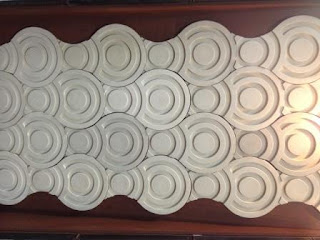Tip #1
Use existing patterns in standard colorways.
Use existing patterns in standard colorways or in-stock tiles.Cement tile offers the creative homeowner, designer or architect the ability to create custom patterns in specific colorways. This benefit comes at a cost because new molds, custom colors, virtual designs and strike-off samples are required to create the tiles and confirm the look prior to a full-order. Leverage your buying dollar by working with existing patterns and colorways, or choose from in-stock tiles. You’ll still get a great looking installation; but, you’ll avoid the time and costs of customization.
Tip #2
Use only plain tiles.
Use only plain tiles or solid color tiles that don't have a pattern. Cement tiles in single colors make great flooring designs while providing a rustic fluidity because of the inherit variation in color. For a bold look, you can also use contrasting alternating colors to create a checkerboard pattern.
Or, choose plain tiles in two or three colors to create a rug design for a room. Consider using a different format for the rug border. For instance, use black 8”x8” tiles for a rug in the center of the room, frame the rug with 4”x8” grey tiles, and fill the area outside the border with 8”x8” white tiles.
Tip #3
Limit the use of patterned tile.
Minimize the quantity of patterned tile required and you can save a bundle - especially on large flooring projects. A tile with a complex pattern or a lot of colors takes longer to make and will have a higher rejection rate. Here's a few great ways to enjoy these tiles and still meet your budget. Make a rug with plain tiles framed in a patterned border tile. Framing a solid color field tile with a decorative border is a great way to use cement tiles. This keeps the design simple but not overpowering. You should consider using plain cement tiles or solid color tiles if you are timid about using the colorful stylistic designs found in many cement tile patterns.Or, create medallions or groupings of four patterned tiles separated by a "grid" or row of solid color tiles. You can reduce the tile cost by 25- to 75-percent when compared to a floor that uses all patterned tiles.
Tip #4
Use large format tiles
Use the largest format or size available to save both manufacturing and installation costs. Generally speaking, a large tile size or format will be much less expensive to manufacture and install than a smaller size format. This is a great choice when using plain cement tiles because you save costs by simply choosing a larger format. We can provide cement tiles up to 14”x14”. You can save 40% by using 12”x12” tiles instead of 4”x4” tiles.
Tile Cost (Unpolished)
|
Tiles
100 SF |
Cost
100 SF | |
4”x4”
|
$1.29
|
930
|
$1,200
|
8”x8”
|
$3.89
|
230
|
$900
|
12”x12”
|
$7.20
|
100
|
$720
|
Tip #5
Avoid dark blue & green colors.
If you can, avoid dark blue and green colors in your pattern or plain cement tiles. Cement tiles are colored with natural pigments. Red, brown and yellow are generally created by adding iron and iron oxide compounds that are abundant and inexpensive. Dark green and blue colors are created with cobalt compounds. Cobalt is the reason these colors will cost more. The saturated blue and deep green colors can add 20% to the cost of the tile.These tips are guaranteed to reduce the costs per square foot of any cement tile project. If you are flexible with your design and colors, these tips will allow you to get more cement tile bang for your buck!
Tell us what you think. Would you consider implementing any of these tips on your cement tile project? Do you have a money-saving tip you’d like to share? Or, do you have a question about cement tile that you’d like answered – share it here!









